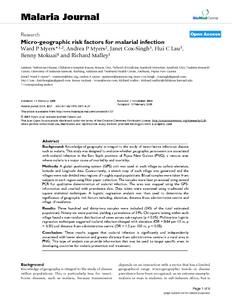Myers, WP; Myers, AP; Cox-Singh, J; Lau, HC; Mokuai, B; Malley, R
(2009)
Micro-geographic risk factors for malarial infection.
MALARIA JOURNAL, 8 (27).
ISSN 1475-2875
https://doi.org/10.1186/1475-2875-8-27
SGUL Authors: Cox-Singh, Janet
![[img]](https://openaccess.sgul.ac.uk/980/1.hassmallThumbnailVersion/1475-2875-8-27.pdf)  Preview |
|
["document_typename_application/pdf; charset=binary" not defined]
Published Version
Download (351kB)
| Preview
|
Abstract
BACKGROUND: Knowledge of geography is integral to the study of insect-borne infectious disease such as malaria. This study was designed to evaluate whether geographic parameters are associated with malarial infection in the East Sepik province of Papua New Guinea (PNG), a remote area where malaria is a major cause of morbidity and mortality.
METHODS: A global positioning system (GPS) unit was used at each village to collect elevation, latitude and longitude data. Concurrently, a sketch map of each village was generated and the villages were sub-divided into regions of roughly equal populations. Blood samples were taken from subjects in each region using filter paper collection. The samples were later processed using nested PCR for qualitative determination of malarial infection. The area was mapped using the GPS-information and overlaid with prevalence data. Data tables were examined using traditional chi square statistical techniques. A logistic regression analysis was then used to determine the significance of geographic risk factors including, elevation, distance from administrative centre and village of residence.
RESULTS: Three hundred and thirty-two samples were included (24% of the total estimated population). Ninety-six were positive, yielding a prevalence of 29%. Chi square testing within each village found a non-random distribution of cases across sub-regions (p < 0.05). Multivariate logistic regression techniques suggested malarial infection changed with elevation (OR = 0.64 per 10 m, p < 0.05) and distance from administrative centre (OR = 1.3 per 100 m, p < 0.05).
CONCLUSION: These results suggest that malarial infection is significantly and independently associated with lower elevation and greater distance from administrative centre in a rural area in PNG. This type of analysis can provide information that may be used to target specific areas in developing countries for malaria prevention and treatment.
| Item Type: |
Article
|
| Additional Information: |
PubMed ID: 19216781
© 2009 Myers et al; licensee BioMed Central Ltd. This is an Open Access article distributed under the terms of the Creative Commons Attribution License (http://creativecommons.org/licenses/by/2.0), which permits unrestricted use, distribution, and reproduction in any medium, provided the original work is properly cited. |
| Keywords: |
Animals, Blood Specimen Collection, DNA, Protozoan, Endemic Diseases, Geographic Information Systems, Geography, Humans, Logistic Models, Malaria, Multivariate Analysis, Papua New Guinea, Parasitemia, Plasmodium, Polymerase Chain Reaction, Prevalence, Risk Factors, Science & Technology, Life Sciences & Biomedicine, Parasitology, Tropical Medicine, PAPUA-NEW-GUINEA, TEMPORAL VARIATION, AREA, TRANSMISSION, EPIDEMIOLOGY, ENDEMICITY, HIGHLANDS, ABUNDANCE, CULICIDAE, TANZANIA |
| Journal or Publication Title: |
MALARIA JOURNAL |
| ISSN: |
1475-2875 |
| Related URLs: |
|
| Web of Science ID: |
WOS:000264577100001 |
| Dates: |
| Date |
Event |
| 2009-02-13 |
Published |
|
  |
Download EPMC Full text (PDF)
|
 |
Download EPMC Full text (HTML)
|
| URI: |
https://openaccess.sgul.ac.uk/id/eprint/980 |
| Publisher's version: |
https://doi.org/10.1186/1475-2875-8-27 |
Statistics
Item downloaded times since 30 Apr 2012.
Actions (login required)
 |
Edit Item |



